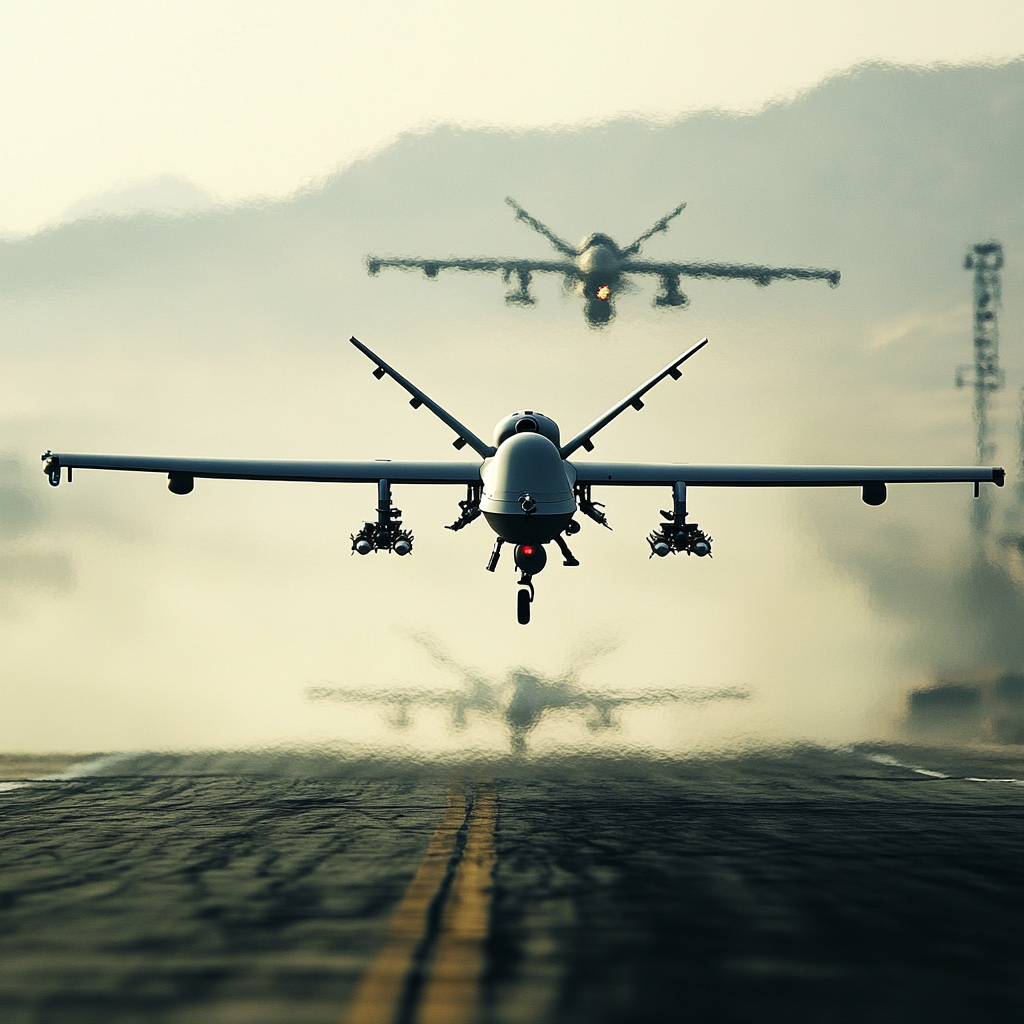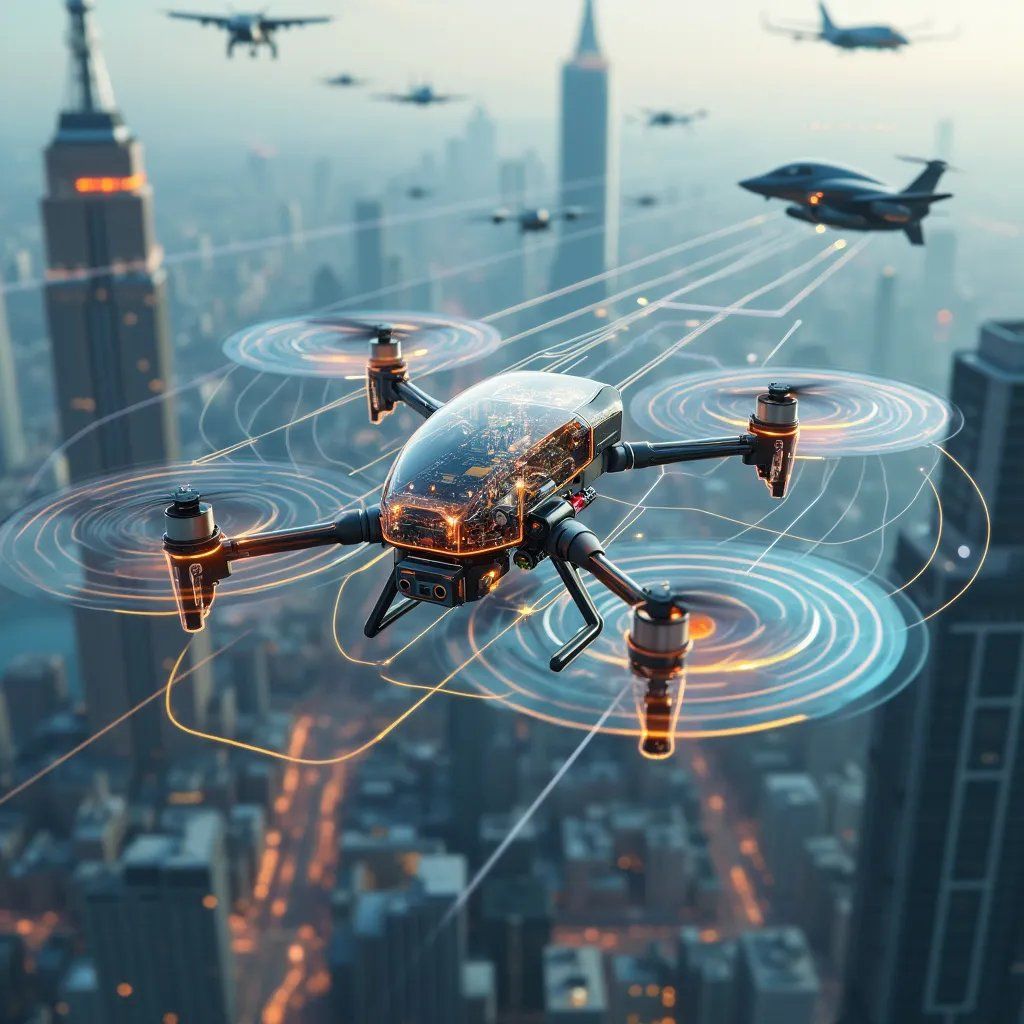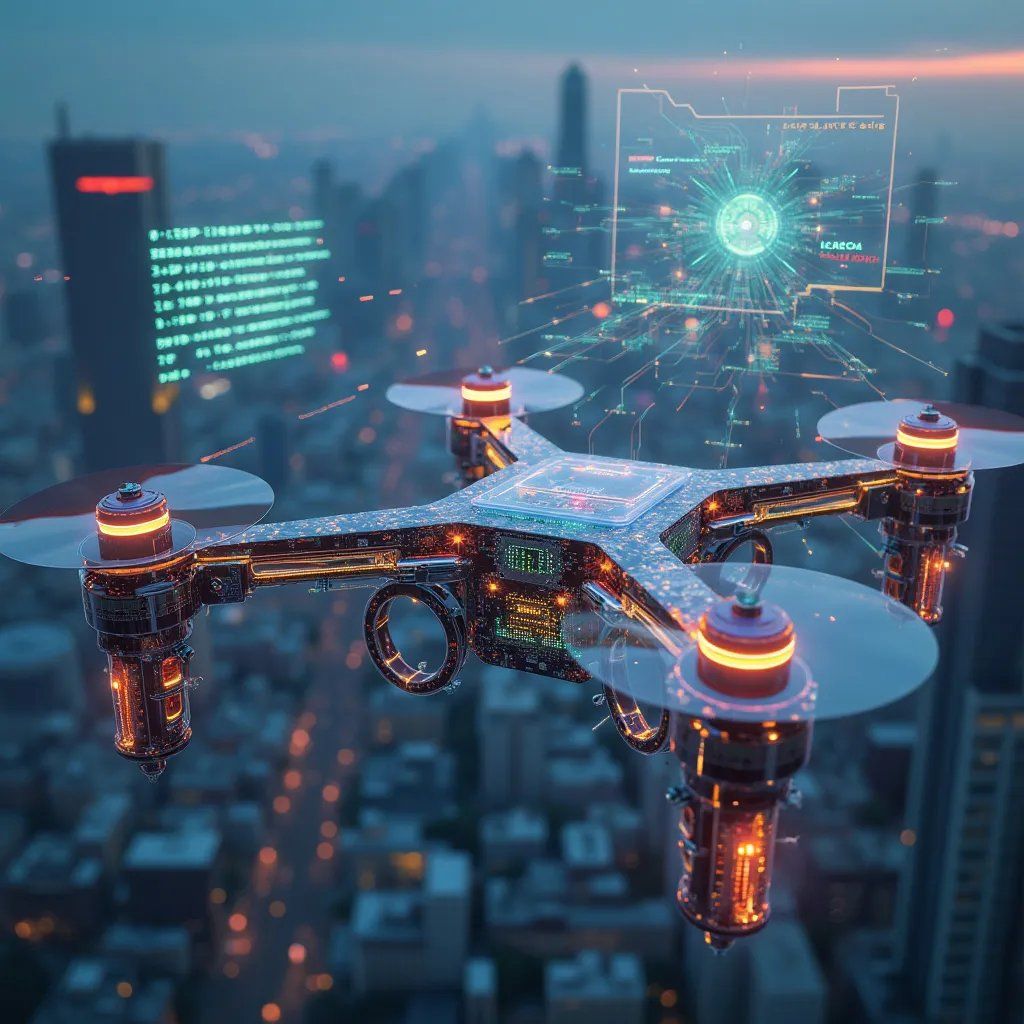Introduction
Identification Friend or Foe (IFF) systems have been a cornerstone of military aviation since their inception during World War II. These systems were originally designed to prevent friendly fire incidents by allowing aircraft to identify themselves as friendly. As unmanned aerial vehicles (UAVs) or drones have proliferated in both military and civilian airspace, the need for robust, secure, and efficient IFF systems for these platforms has grown exponentially. This article explores the fascinating evolution of IFF systems for drones, from their early adaptations to the cutting-edge solutions of today, such as our revolutionary DroneCrypt IFF.
The Origins of IFF Systems
Before delving into drone-specific IFF systems, it’s crucial to understand the historical context of IFF technology. The concept of IFF originated in the 1930s, with the first operational IFF system, the Mark I, deployed by the Royal Air Force in 1940. These early systems used a simple challenge-response mechanism: a ground-based radar would send a coded ‘challenge’ signal, and friendly aircraft would respond with the correct code.
As technology advanced, so did IFF systems. The introduction of secondary surveillance radar (SSR) in the 1950s marked a significant leap forward, allowing for more complex and secure identification methods. These systems formed the basis for modern air traffic control and military aircraft identification.
Early Adaptations of IFF for Drones
The initial integration of IFF systems into drones largely involved adapting existing aircraft IFF technology. These early drone IFF systems typically used transponders that would respond to interrogation signals with a preset code, allowing operators to distinguish friendly drones from potential threats.
Military Applications
In military contexts, early drone IFF systems were primarily concerned with preventing friendly fire incidents and maintaining situational awareness. These systems often used encrypted communications to prevent adversaries from intercepting or spoofing IFF signals. However, the limited processing power and payload capacity of early drones posed significant challenges in implementing robust IFF solutions.
Civilian Adaptations
As drones began to find applications in civilian sectors such as agriculture, surveying, and photography, the need for IFF systems in non-military contexts became apparent. Early civilian drone IFF systems were often simplified versions of their military counterparts, focusing more on compliance with aviation regulations than on security against hostile intervention.
Challenges in Drone IFF Systems
As drone technology advanced and its applications diversified, several challenges emerged in IFF systems:
1. Size and Power Constraints
Unlike larger aircraft, drones have limited payload capacity and power resources. This necessitated the development of more compact and energy-efficient IFF solutions. Early attempts to simply miniaturize existing IFF systems often resulted in reduced range or functionality, prompting the need for innovative approaches to drone identification.
2. Increased Threat Sophistication
The rise of cyber threats and electronic warfare capabilities made traditional IFF systems vulnerable to a range of attacks:
- Spoofing: Adversaries could potentially mimic IFF signals of friendly drones, leading to security breaches or confusion in operational environments.
- Jamming: Electronic warfare techniques could disrupt IFF communications, rendering the systems ineffective.
- Interception: Insufficiently secured IFF signals could be intercepted, potentially revealing sensitive information about drone operations.
These threats necessitated the development of more secure and resilient IFF systems for drones.
3. Civilian Airspace Integration
The growing use of drones in civilian applications required IFF systems that could integrate seamlessly with air traffic control and comply with aviation regulations. This presented unique challenges:
- Regulatory Compliance: IFF systems needed to meet the standards set by aviation authorities in different jurisdictions.
- Interoperability: Civilian drone IFF systems needed to communicate effectively with existing air traffic management infrastructure.
- Privacy Concerns: The need to balance identification requirements with privacy considerations for civilian drone operators.
4. Scalability
The proliferation of drones in both military and civilian sectors demanded IFF systems capable of handling a much larger number of simultaneous identifications. This scalability challenge was particularly acute in scenarios involving drone swarms or dense urban environments with numerous UAVs operating in close proximity.
Advancements in Drone IFF Technology
To address these challenges, IFF systems for drones have evolved significantly, incorporating a range of innovative technologies and approaches:
Cryptographic Security
Modern drone IFF systems have incorporated advanced cryptographic techniques to enhance security. These developments include:
- Symmetric Key Algorithms: Utilizing fast, secure encryption methods for real-time communication.
- Public Key Infrastructure (PKI): Implementing certificate-based authentication for enhanced trust and security.
- Rolling Codes: Employing constantly changing identification codes to prevent replay attacks.
For instance, the STANAG 4193 standard, widely used in NATO countries, incorporates cryptographic techniques to secure Mode 5 IFF communications, providing a model for secure drone identification [1].
Integration with ADS-B
For civilian applications, many drone IFF systems now integrate with Automatic Dependent Surveillance-Broadcast (ADS-B) technology. This integration offers several benefits:
- Enhanced Visibility: Drones can broadcast their position and identity, improving their visibility to air traffic control and other aircraft.
- Compliance: ADS-B integration helps meet regulatory requirements in many jurisdictions.
- Traffic Management: Facilitates the development of unmanned aircraft system traffic management (UTM) systems.
Research by Kopardekar et al. (2016) highlights the importance of ADS-B integration in developing comprehensive UTM solutions [2].
AI and Machine Learning
The integration of artificial intelligence and machine learning algorithms has significantly improved the ability of IFF systems to detect anomalies and potential threats. These advanced systems can:
- Analyze Patterns: Detect unusual behavior in IFF responses that might indicate spoofing attempts.
- Predict Trajectories: Anticipate potential conflicts or security risks based on drone flight patterns.
- Adaptive Security: Dynamically adjust security protocols based on perceived threat levels.
Studies, such as the one conducted by Brust et al. (2017), demonstrate the potential of AI-powered systems in enhancing drone swarm security [3].
Blockchain Technology
Some cutting-edge IFF solutions, including our DroneCrypt IFF, have begun to leverage blockchain technology for secure, decentralized management of drone identities. This innovative approach offers several advantages:
- Immutable Record: Creating an unalterable log of drone identities and activities.
- Decentralized Trust: Eliminating the need for a central authority to manage identities.
- Enhanced Scalability: Facilitating efficient management of large numbers of drone identities.
Research by Michelin et al. (2019) explores the potential of blockchain in securing UAV networks, providing a foundation for blockchain-based IFF systems [4].
The Next Generation: Quantum-Resistant IFF
As quantum computing technology advances, there is growing concern about the vulnerability of current cryptographic systems. The next evolution in drone IFF systems is the development of quantum-resistant cryptography to ensure long-term security.
The Quantum Threat
Quantum computers, when fully realized, will have the potential to break many of the cryptographic algorithms currently used in IFF systems. This poses a significant threat to the long-term security of drone identification and communication systems.
Post-Quantum Cryptography
To address this looming threat, researchers and cybersecurity experts are developing post-quantum cryptographic algorithms. These algorithms are designed to resist attacks from both classical and quantum computers.
DroneCrypt IFF: A Quantum-Resistant Solution
Our DroneCrypt IFF system represents the forefront of this evolution. By integrating post-quantum cryptographic algorithms like CRYSTALS-Kyber for key encapsulation and CRYSTALS-Dilithium for digital signatures, DroneCrypt IFF provides a future-proof solution that can withstand potential threats from quantum computers.
Key features of DroneCrypt IFF include:
- Quantum-Resistant Algorithms: Utilizing lattice-based cryptography for 256-bit post-quantum security level.
- High-Speed Performance: Achieving key generation, encapsulation, and decapsulation times of less than 1ms.
- Blockchain Integration: Leveraging Hyperledger Fabric for secure, decentralized management of drone identities.
- AI-Enhanced Security: Employing machine learning models for real-time anomaly detection and threat assessment.
This approach ensures that drone identification remains secure even as computational capabilities continue to advance, positioning DroneCrypt IFF at the cutting edge of drone security technology.
Future Trends in Drone IFF Systems
As we look to the future, several emerging trends are likely to shape the continued evolution of drone IFF systems:
1. Swarm Intelligence
As drone swarm technology advances, IFF systems will need to evolve to handle collective identification and authentication. This may involve developing new protocols for swarm-wide identity management and intra-swarm communication.
2. Edge Computing
The integration of edge computing in drone systems could allow for more sophisticated on-board processing of IFF data, reducing latency and improving response times in critical situations.
3. 5G and Beyond
The rollout of 5G networks and future telecommunications technologies will likely play a significant role in drone IFF systems, enabling faster, more secure, and more reliable communication between drones and ground control stations.
4. Adaptive Spectrum Usage
As the electromagnetic spectrum becomes increasingly crowded, future IFF systems may need to employ adaptive spectrum usage techniques to ensure reliable communication in contested environments.
5. Biometric Integration
For enhanced security, particularly in sensitive operations, future drone IFF systems might incorporate biometric authentication of operators, adding an extra layer of verification to drone identity.
Conclusion
The evolution of IFF systems for drones reflects the rapid advancement and diversification of drone technology itself. From simple transponder-based systems to sophisticated, AI-enhanced, blockchain-secured, and quantum-resistant solutions like DroneCrypt IFF, these systems have adapted to meet the growing challenges of drone identification and security.
As drones continue to play an increasingly important role in both military and civilian applications, the evolution of IFF systems will undoubtedly continue. Future developments may include even more advanced AI capabilities, enhanced integration with global air traffic management systems, and novel approaches to securing drone communications in increasingly contested electromagnetic environments.
The journey from the early days of IFF to cutting-edge solutions like DroneCrypt IFF demonstrates the incredible pace of technological advancement in this field. As we look to the future, it’s clear that IFF systems will remain a critical component in ensuring the safe, secure, and efficient operation of drones in our skies.
References
[1] NATO Standardization Office. (2016). STANAG 4193: Technical Characteristics of IFF Mk XIIA and Mode S Interrogators and Transponders.
[2] Kopardekar, P., Rios, J., Prevot, T., Johnson, M., Jung, J., & Robinson III, J. E. (2016). Unmanned aircraft system traffic management (UTM) concept of operations. AIAA Aviation Technology, Integration, and Operations Conference.
[3] Brust, M. R., Danoy, G., Bouvry, P., Gashi, D., Pathak, H., & Gonçalves, M. P. (2017). Defending against intrusion of malicious UAVs with networked UAV defense swarms. 2017 IEEE 42nd Conference on Local Computer Networks Workshops (LCN Workshops), 103-111.
[4] Michelin, R. A., Dorri, A., Lunardi, R. C., Steger, M., Kanhere, S. S., Jurdak, R., & Zorzo, A. F. (2019). UAVchain: A Blockchain-based Secure UAV Network. 2019 IEEE Wireless Communications and Networking Conference (WCNC), 1-6.
[5] National Institute of Standards and Technology. (2022). Post-Quantum Cryptography Standardization. https://csrc.nist.gov/Projects/post-quantum-cryptography/post-quantum-cryptography-standardization
[6] Shrestha, R., Nam, S. Y., Bajracharya, R., & Kim, S. (2020). Evolution of IFF Systems and Their Integration in Modern Warfare. IEEE Access, 8, 212998-213020.
[7] Chuang, J., & Nguyen, H. (2021). Blockchain-Based Drone Identity Management System. In Proceedings of the 2021 International Conference on Unmanned Aircraft Systems (ICUAS), 1123-1128.







